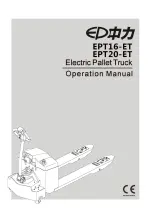
• Consult your Komatsu distributor to disassemble the machine for transportation.
PRECAUTIONS WHEN LOADING AND UNLOADING
If handling is improper when loading or unloading the machine, it is dangerous that the machine may tip over or
fall. It requires particular attention. Always observe the following.
• Perform loading and unloading on a firm, level ground only. Avoid road edge or place near the cliff.
• Always use ramps of adequate strength. Be sure that the
ramps are wide, long, and thick enough to provide a safe
loading slope. Take suitable steps to prevent the ramps
from moving out of position or coming off.
(1) Chocks
(2) Ramp
(3) Width of ramps: Same width as tires
(4) Angle of ramp: Max. 15°
(5) Block
• Be sure the ramp surface and the platform of trailer are
clean and free of grease, oil, ice, water and other loose
materials. If any, remove them. Remove dirt around the undercarriage of the machine. On a rainy day, in
particular, be extremely careful since the ramp surface is slippery.
• Run the engine at low idle and drive the machine slowly at low speed.
• Never correct your steering on the ramps. If necessary, drive off the ramps onto the ground, correct the di-
rection, then enter the ramps again.
• When unloading to an embankment or platform, make sure that it has suitable width, strength, and grade.
• For machines equipped with a cab, always lock the door after loading the machine. To prevent the door
from opening during transportation.
• When it is necessary to remove handrails and steps, take care not to lose removed handrails and steps.
Install the removed handrails and steps securely.
TOWING AND BEING TOWED
PRECAUTIONS FOR TOWING AND BEING TOWED
Always use the correct towing equipment and towing method. Any mistake in the selection of the wire rope or
drawbar or the method of towing a failed machine and being towed may lead to serious personal injury or death.
• Always confirm that the wire rope or drawbar used for towing has ample strength for the weight of the ma-
chine being towed.
• Never use the wire rope which has breaks in strands (A),
reduced diameter (B), or kinks (C). There is a danger that
the rope may break during the towing operation.
• Always wear leather gloves when handling the wire rope.
• Never tow a machine on a slope.
• During the towing operation, never stand between the tow-
ing machine and the machine being towed.
SAFETY
PRECAUTIONS FOR OPERATION
2-27
Summary of Contents for HD325-8
Page 2: ......
Page 13: ...FOREWORD INTRODUCTION 1 11 ...
Page 25: ...LOCATION OF SAFETY LABELS SAFETY SAFETY LABELS 2 3 ...
Page 26: ...SAFETY LABELS SAFETY 2 4 ...
Page 340: ......
Page 424: ......
Page 425: ...SPECIFICATIONS 5 1 ...
Page 429: ...ATTACHMENTS AND OP TIONS Before reading this chapter read and understand the SAFETY 6 1 ...
Page 447: ...REPLACEMENT PARTS 7 1 ...
Page 463: ......






































